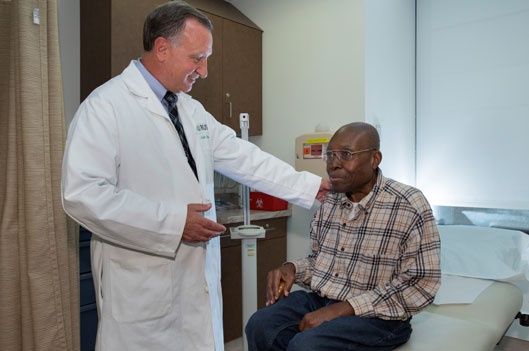Rush University Medical Center is first to try new treatment
A groundbreaking new surgery potentially could be an effective treatment for otherwise inoperable pancreatic cancer.
A surgeon at Rush University Medical Center is the first in the world to successfully treat a patient with inoperable, stage IV pancreatic cancer and partial kidney cancer using a surgical tool that selectively kills cancerous tissue without harming healthy cells.
Called the Canady Helios Cold Plasma Scalpel, the device uses cold atmospheric plasma to eradicate microscopic cancerous tissue and cells while sparing normal cells and tissue.
Plasma is an ionized gas that when generated at low temperatures is called cold atmospheric plasma. It does not cause thermal damage to the tissue. Cold atmospheric plasma is an electronically charged gas that contains reactive nitrogen, oxygen and photons that chemically interact with cancer cells, selectively inhibiting cancer cell growth and migration in culture and animal models.
“Cold atmospheric plasma can attach to and attack the cancer cells and leave healthy tissue unharmed,” said Keith W. Millikan, MD, professor of surgery at Rush, who performed the surgery on a patient. “Without this procedure, there would have been no other options for the patient.”
The U.S. Food and Drug Administration approved use of the cold plasma scalpel in 2015 to treat colorectal cancer patients, but the surgery at Rush was the first use of it in a pancreatic cancer case.
The FDA gave a one-time humanitarian compassionate use exemption to US Medical Innovations, LLC, which created the surgical tool. Millikan used the device for this case at Rush.
Device potentially offers hope for often hopeless cases
The cold plasma scalpel potentially offers a new line of treatment for a form of cancer that usually leaves patients with little hope. “Pancreatic cancer often has a poor prognosis even when diagnosed early,” Millikan said.
“The cancer typically spreads rapidly and is seldom detected in its early stages, which is why it is a leading cause of cancer death. Signs and symptoms often do not appear until pancreatic cancer is quite advanced and complete surgical removal is not possible.”
As a result, pancreatic cancer causes 7 percent of all cancer deaths in the United States, even though they only account for 3 percent of all cancer cases in the U.S., according to the American Cancer Society. The organization estimates that about 53,000 people in the United States will be diagnosed with pancreatic cancer this year, and about 42,000 people will die of the disease.
“This tool could be a promising potential treatment for pancreatic cancer,” said Millikan. “Pancreatic cancer is not curable at this point, but this device may help us to increase the cure rate in local occurrence.”
Cold atmospheric plasma spray cleanses margins of removed tumor
Pancreatic cancer begins in the tissues of your pancreas — an organ in the abdomen that lies horizontally behind the lower part of the stomach. The pancreas secretes enzymes that aid digestion and hormones that help regulate the metabolism of sugars.
The Rush patient received preoperative chemotherapy and radiation therapy to reduce the tumor. Afterwards, the patient underwent a surgery called the Whipple procedure, which removed parts of the patient’s pancreas, stomach and small intestine, as well liver tumor nodules and the patient’s right kidney. Following this procedure, Millikan used the cold plasma scalpel to spray the tissue immediately surrounding the tumor with cold atmospheric plasma.
“The key features that make the device unique is that it can be used against tissue that cannot be removed, such as key structures vital for life,” Millikan says. “It also provides a better surgical margin of resection than conventional surgery, when the surgeon thinks he or she has taken all cancer out, but there still in a lot of cases are microscopic cancer cells at the margin of resection.”
“We hope we can get FDA approval for a clinical trial to test and see if this could be a treatment for those who otherwise have no other options left,” Millikan said.

